
Paul Hindemith |
About Life and Work and Effect
Part II
Here you will find part I of Paul Hindemith "From Life, Work and Effect" ...
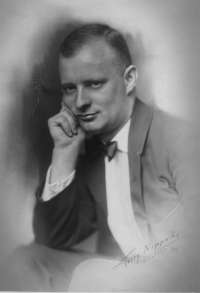 Film Music and Electronic Compositions
Film Music and Electronic CompositionsDuring his teaching at the Berlin Music Academy, Hindemith also devoted himself to composing film music and experimenting with new instruments, such as the electronic Trautonium, developed by Friedrich Trautwein in 1930. For the Trautonium, among other things, he even wrote a concert with an orchestra.
„Serious and Great Music“
In 1931 Hindemith wrote in a letter: „It nows seems like a wave for serious and great music is gradually approaching“. His change in style is characterized in the online biography of the „Foundation Hindemith“ as follows:
„The term «Konzertmusik» describes with the institution of the «Konzert» (concerto) what is representative of this music, which is simpler, more accessible, more transparent, more harmonically regulated and more plastically formed than the series of Kammermusiken Nos. 1-7. All harshness, coarseness and avant-garde characteristics are expunged, as are sobriety and objectivity.“
Theodor W. Adorno commented on the "Philharmonic Concert" of Hindemith: „[…] the melodic language is characterised by plasticity and relieved of all arbitrariness; the harmony is in control. In this capacity, there is nothing to prevent it from having clear recourse to tonality, as is already laid out in the main melodic motif: the point is simply that harmonic and melodic problems are posed in place of merely rhythmical and contrapuntal ones; if they are pursued consistently enough, they will, out of themselves, lead to both the purification and activation of Hindemith's style that seems to me to be required of it.“
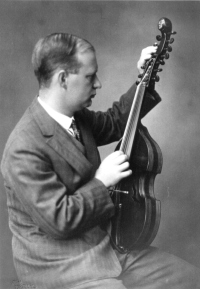 Hindemith and the Third Reich
Hindemith and the Third ReichWhile some National Socialists initially tried to win Hindemith for their movement, he was at the same time the focus of others, as he had two Jews in his trio with Feuermann and Goldberg, and his wife was half-Jewish.
In 1934, Hindemith became a council member of the Reichsmusikkammer. Shortly afterward, however, there was a scandal, after the premiere of his work "Mathis der Maler" conducted by Wilhelm Furthwängler and played by the Berliner Philharmoniker. After Hindemith was heavily criticized, Furthwängler, whom the National Socialists at that time fawned, protected him in a newspaper article "The Hindemith Case." But when the Minister of Propaganda, Joseph Goebbels, took a position and called Hindemith an "atonal sound-maker," Hindemith took time off his Berlin professorship.
The Eclat led to the fact that Hindemith's works were performed hardly in Germany in the following years. Also, his concert activity in Germany declined and for concerts outside of Germany he needed permission from the Reichsmusikkammer.
In 1935, Hindemith finished the "Schwanendreher." He produced this piece with a view to his concert activities. The play, which he never performed in Germany, refers to his situation in the Third Reich. For example, the melodies his viola plays are taken of folksongs, whose text is "I can bear it no longer" and "I have an utterly sad day.“
After mediation by Furthwängler, Hindemith took the task of assisting the Turkish government in building musical academies. For teaching, he usually brought Jewish musicians from Germany to Turkey, who were thus able to escape the persecution.
After the premiere of his "Sonata in E for violin and piano" was a success, the regime replied with a general ban on the performance of his works.
In 1937, Hindemith resigned from his position at the music academy. From 1938 on, his art was dispraised as "entartete Kunst" (degenerated art) by the Nazi regime.
New territory
Hindemith made his first journey to the USA in 1937. He went on a concert-tour and, among others, he premiered the freshly composed "Sonate für Bratsche solo" (Sonata for Viola Solo) in Chicago. The trip to the USA left him with a lasting impression and later he was to find a home here.
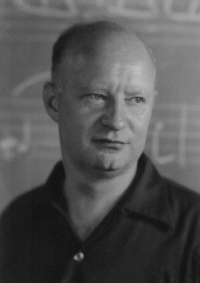 Before that, Hindemith and his wife moved to Bluche, Switzerland. About the move to Switzerland and the departure from Germany, Hindemith wrote to his friend Willy Strecker in 1938: "There are only two things worth striving for: decent music and a pure conscience, and both are being taken care of now."
Before that, Hindemith and his wife moved to Bluche, Switzerland. About the move to Switzerland and the departure from Germany, Hindemith wrote to his friend Willy Strecker in 1938: "There are only two things worth striving for: decent music and a pure conscience, and both are being taken care of now."In 1939 he commented retroactively on his situation in Germany: "The artistic measure taken in Germany is completely in line with all the undertakings of the Reich, which still seems to be dictated solely by megalomania, sadism, and lack of raw materials. I always feel like a mouse who recklessly danced in front of the trap door and also went in; by chance, when it was outside for a moment, the door snapped shut!"
New Artistic Territory
In his work „Die Unterweisung im Tonsatz, Theoretischer Teil“ (The Craft of Musical Composition: Theoretical Part), Hindemith wrote down his experiences as a composition teacher in 1937. The work dealt with the relationships between tones and went on to the basic rules behind the music.
In 1939, the second part "Book 2: Exercises in two-part writing" appeared. The third part, dealing with the three-part writing was published posthumously in 1970.
From 1935 to 1955 Hindemith wrote 26 sonatas for wind instruments, strings, piano, organ and harp. He wrote to Strecker: "You will be surprised that I am writing sonatas for all the wind instruments. I already wanted to write a whole series of these pieces. First of all, there's nothing decent for these instruments except for a few classical things; although not from the present business perspective, it is meritorious over the long term to enrich this literature. And secondly, since I myself have been so interested in playing wind instruments, I have great pleasure in these pieces.[...]"
In fact, Hindemith himself played all the above mentioned instruments, with the exception of the harp.
In 1936, Hindemith was in England on a concert tour in Britain, where he composed his well-known "Trauermusik“ (mourning music) within a day, due to the death of the English King George V. One day later he performed the piece instead of the „Schwanendreher.“ In addition to the solo version for the viola he later published one for the violin and the violoncello.
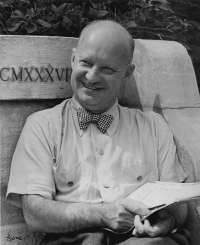 Hindemith's opera "Mathis der Maler" ("Mathis the Painter") can surely be called a milestone. He wrote the libretto for this opera himself. After the cooperation with Brecht failed, Hindemith first sought the cooperation with Gottfried Benn. Together they wrote the oratorio "Das Unaufhörliche“ (The Unending). However, when Benn admitted to National Socialism, Hindemith turned away from him.
Hindemith's opera "Mathis der Maler" ("Mathis the Painter") can surely be called a milestone. He wrote the libretto for this opera himself. After the cooperation with Brecht failed, Hindemith first sought the cooperation with Gottfried Benn. Together they wrote the oratorio "Das Unaufhörliche“ (The Unending). However, when Benn admitted to National Socialism, Hindemith turned away from him.With "Mathis der Maler," Hindemith reflected on one level his situation as an artist in the Third Reich. The biography of the "Foundation Hindemith" said: "In Hindemith's depiction, Mathis is an artist who gives up painting out of social responsibility, taking sides with the downtrodden but then ending up bitterly disappointed by them. He recognises that he has betrayed what is best in him: his art. It is restored to him as a «commission» to paint, but he cannot forget his experiences of misery and powerless complicity. They grow with his art as moral strength and energy. Mathis realises that the artist who betrays his abilities remains socially useless and without responsibility, however much he may ease his conscience through activism. Hindemith himself apparently adopted this stand; it enabled him to withstand the mounting political pressure."
The premiere took place in Zurich in 1938.
How the West was won - moving to the USA
After initial skepticism against the "land of limited possibilities" such as Hindemith once called the United States, he soon found himself in the new homeland. In 1940, Hindemith emigrated to the United States. After getting out with a teaching position in Buffalo at the beginning, his wife followed to the USA from Switzerland, when he took a professorship in Yale for the winter semester 1940/1941. Until 1953 he taught here.
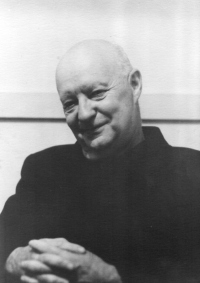 In 1946 Paul and his wife Gertrude Hindemith became American citizens. Hindemith was grateful to the country and the people. Especially for the way they were accepted as Germans, though from the "enemy-country", and also the initial skepticism towards the "American Way of Life" gave way to gratitude for the personal freedom in the new home and an understanding of the American way of life
In 1946 Paul and his wife Gertrude Hindemith became American citizens. Hindemith was grateful to the country and the people. Especially for the way they were accepted as Germans, though from the "enemy-country", and also the initial skepticism towards the "American Way of Life" gave way to gratitude for the personal freedom in the new home and an understanding of the American way of lifeThe emigration also had a very positive effect on the artistic success of Hindemith. His plays were at that time more frequently performed in the USA than that of any other living composer. He received numerous honors and honorary doctorates, an honorary banquet by Dwight D. Eisenhower, and an invitation to the installation of John F. Kennedy.
Hindemith and the old music
Konrad Ewald wrote about Hindemith: "He knows the instruments, so to speak, and he also knows the older music, which could not be asserted by every new composer." Hindemith began to play the viola d'amore in the 1920s. From 1927 he gave concerts with the viola d'amore, accompanied by harpsichord and violin. From 1943 on, at a recurring event called "Collegium Musicum" at Yale University, he began to perform old music with pupils and other musicians. Hindemith emphasized the authenticity of the old music in the concerts. He conducted or performed the viola d'amore, viola da gamba, the bassoon, or the vielle.
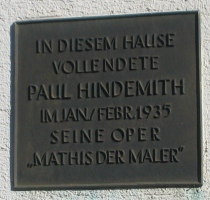 Time after War
Time after WarFrom 1945, after World War II, Hindemith's works enjoyed great popularity in Germany again. Hindemith however rejected offers to go back to Germany and help rebuilding the musical life there.
After traveling through Europe, 1951, Hindemith startet to exercise professorships in Zurich and Yale, parallel. In 1953, however, he decided to move back to Switzerland and resumed his work in Yale.
Then Hindemith focussed on his activity as a (guest-) conductor and also started to conduct foreign works.
The Death of Hindemith
On his 68th birthday (16 November 1963), Paul Hindemith fell ill. To clarify the cause of the disease, he was sent to a hospital. On 9 December, Hindemith then suffered strokes that led to his death on 28 December 1963. The cause was, as was later stated, a bleeding of the pancreas.
His wife, Gertrude Hindemith, began to sort his works after Paul's death and prepared his inheritance. She died
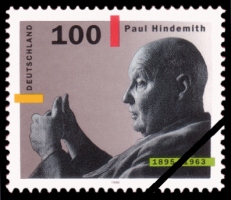 on 13 May 1967.
on 13 May 1967.Hindemith mainly enriched the repertoire of the viola with his life's work. He wrote seven sonatas alone and in regard to his work as a violist, numerous solo pieces for the viola.
Today's soloists of the viola can hardly pass Hindemith.
"Paul Hindemith is the great practitioner of the 20th century. He was a violist and violinist, he was an orchestral musician, quartets, soloist, conductor, music teacher and writer. "
This Konrad Ewald wrote about the composer. Here it is easy to see, what varied talents Hindemith was blessed with. As an instrumentalist, especially as a violist, he already gained much fame during his lifetime. His compositions, however, gave him a place in the history books, beyond.
Sources and further reading:
http://www.hindemith.info
https://en.wikipedia.org/wiki/Paul_Hindemith
https://en.wikipedia.org/wiki/Wilhelm_Furtwängler#Furtw.C3.A4ngler_in_der_Zeit_des_Nationalsozialismus
http://www.kammermusikfuehrer.de/werke/929 (German)
Pictures:
Paul and Gertrud Hindemith 1945: http://www.hindemith.info/fileadmin
Honorary Doctorate of the Columbia University 1948: http://www.hindemith.info/fileadmin/_processed
Hindemith conducting in Hamburg, 1960: http://www.hindemith.info/fileadmin/_processed_/csm
Paul und Gertrud Hindemith 1963: http://www.hindemith.info/fileadmin/_processed_/csm_L-8
Sound examples online:
https://www.youtube.com/watch?v=NkFbrUEhSCc
Der Schwanendreher
hr-Sinfonieorchester (Frankfurt Radio Orchestra)
Antoine Tamestit: Viola
Paavo Järvi: Conductor
Recorded 14 Dezember 2012 at the „Alte Oper“ Frankfurt
Trauermusik
https://www.youtube.com/watch?v=hTPM-Ts6czo
RCA Victor Symphony Orchestra
Paul Hindemith: Viola
Bruno Reibold: Conductor
Recording from April 1939
A blog article by Mascha Seitz.
Pictures: © Fondation Hindemith, Blonay (CH)
Add comment
| Blog overview |
» To the blog list
| Newsletter |
 Do you don't want to miss any news regarding viola anymore? Our newsletter will keep you informed.
Do you don't want to miss any news regarding viola anymore? Our newsletter will keep you informed.» Subscribe to our Newsletter for free
 Visit us on Facebook. The news articles are also posted.
Visit us on Facebook. The news articles are also posted.» To Facebook